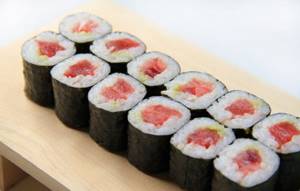Sushi masters are not born, sushi masters are made. And if you are not afraid of dangers and the techniques are precise, everything will definitely come true. This is an effective spell for a cook mastering the subtleties and wisdom of Japanese cuisine. Let's add a little theory, an impressive amount of practice - and it's all in the bag. Every Japanese will tell you that the main thing is the right filling for the rolls. And if even special machines have learned to make rolls, then it won’t be difficult for an intelligent individual.
Ingredients for sushi and rolls: the devil is not as scary as they paint
Fans of sushi and rolls, holding hands together, could probably hug the globe. This unique dish of seafood and rice not only made the small island state famous throughout the world, but also quickly won the hearts of Russians. However, today few people know what ingredients for rolls are best to use to prepare a delicious dish.
But first we need to decide on complex terminology that sounds exotic to our ears. Sushi, as sushi is called in Japan, is a savory dish of rice and seafood. Sushi rolls are also called rolls (they differ in shape) and are a special type of sushi. Rolls (also known as sushi rolls and makizushi) are formed using a special bamboo mat called makisu. It is this that gives them the appearance of a roll, which, after cooking, is cut into equal parts and served.
However, the difference between sushi and rolls is that “rolls” have a slightly rounded shape, which is why they got their name (from the English “roll” - “roll; package”), while sushi are oblong lumps of rice, seasoned with spices and covered with a miniature slice of fresh (marinated) fish or seafood and neatly tied with a special seaweed ribbon. It should be remembered that the filling used in rolls and sushi may be different, as well as seasonings and even the manner of combining them.
Additional Ingredients
Special seasonings are required: wasabi, ginger, soy sauce. Their presence is not a tribute to tradition, but a necessity. When preparing maki, no spices are added or salted (except when seasoned products are used, for example, smoked fish). The Japanese balance the taste with soy sauce. It is customary to dip each piece of roll into it before putting it in your mouth.
Wasabi plays the role of not only a spicy, spicy seasoning (the taste is vaguely reminiscent of a mixture of mustard and horseradish). It acts as an antiseptic. The fact is that traditionally Japanese cuisine uses raw seafood. Because of this, there is a high risk of becoming infected with parasites, the larvae of which are present in almost any fish or mussels. The burning components in wasabi suppress their activity, providing “disinfection” in the stomach.
Pickled ginger is another traditional ingredient in sushi and maki. Its spicy and slightly pungent taste is pleasantly refreshing. It is for this purpose that it is served. According to etiquette, you need to eat a pickled ginger petal before each new type of maki or sushi to cleanse the taste buds of the taste of the previous dish.
However, stocking up on everything you need is only half the battle. To enjoy a delicious dish, you need to cook it. At first glance, there is nothing complicated about the technology: the filling is placed on a layer of boiled rice and rolled into a roll. In fact, cooking is a whole philosophy. It’s not for nothing that in Japan, chefs used to study the art of creating sushi and maki for 10 years! The process itself involves many nuances, and we will now consider the main ones.
Cooking the filling in Japanese style
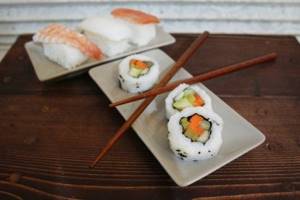
To prepare a filling for rolls that is not inferior in taste to the work of an experienced Japanese cook, you need to boil special Japanese rice (you can buy it in a hypermarket by asking the sales assistant for round rice), then mix it with a suspension of rice vinegar, add a little salt and sugar for piquancy. That's not all the ingredients for the rolls: you'll also need traditional mirin, seaweed and sake.
“Mosaic” and “colored” rolls, as well as “inside out rolls” and other varieties have gained worldwide popularity. As practice has shown, the process of preparing them is not so complicated, the main thing is to carefully familiarize yourself with the technology. That's why you can easily prepare them even at home. In the 70s, Japanese robots “worked” on their production.
TOP secrets of making rolls
You can make delicious poppies only if you use the right products and strictly follow the technology. Otherwise, you’ll just end up with rice and fish – a bland and downright tasteless dish. To create a delicacy, it is worth considering several secrets used by professional sushi chefs:
- All products must be the freshest. It is unacceptable to use yesterday's rice or frozen fish! Seafood in the Land of the Rising Sun is eaten literally alive or as soon as possible after catch. It is believed that only in this case the maximum amount of useful substances is concentrated in them.
- Rice is cooked in a special way. In our case, the cereal is poured into a pan with water and brought to readiness over low heat for 15-20 minutes. In Japan, such prolonged thermal exposure is not acceptable. The longer food is cooked, the less beneficial it is. Therefore, the rice is first soaked and then boiled for literally 10 minutes. This processing is enough for it to be ready.
- The rice is marinated. Remember that spicy sweet and sour taste when you eat rolls? So, it is due to the fact that after cooking the porridge is soaked for several minutes in a solution of rice vinegar (it is very delicate) and sugar.
- You need to work with ingredients exclusively with cold tools (this is especially important when cutting fish). It is believed that any, even minimal, thermal exposure destroys beneficial substances. And it is for this reason that in the Land of the Rising Sun, only men were previously allowed to prepare sushi and maki. It is believed that their body temperature is usually lower than that of women (by about 1 degree), that is, their hands are cooler, and food is less susceptible to heat treatment.
- To cut the roll into portioned pieces, use a very sharp knife dipped in cold water. This is the only way to carefully separate the sticky rice without damaging the structure of the roll.
Considering all the nuances and subtleties, it becomes clear that preparing truly delicious poppies at home is very difficult and troublesome. It’s much easier to place an order with a delivery service and literally enjoy your favorite Japanese delicacy within an hour.
The cooking technology looks quite simple
- manually form oblong “lumps” using rice;
- spread a thin layer of wasabi on them (a special Japanese green that tastes similar to horseradish);
- season with a thin piece of the chosen filling (real Japanese sushi and rolls are made only from raw or marinated fish);
- We carefully bind the resulting consistency with a strip of edible red noria algae.
You will definitely end up with the simplest type of sushi, which in Japanese sounds like “nigiruzushi”. By the way, the fillings for sushi and rolls can be different, it all depends on your taste preferences.
Classic Japanese tuna rolls
Sushi rolls, or Hosomaki, are very simple but popular sushi in Japan. Due to the simplicity of the ingredients and preparation techniques, they are very widespread. Hosomaki consists of one main ingredient and is usually wrapped in nori on the outside. They are commonly served in restaurants and, of course, can be easily prepared at home. The two most common types of thin rolls are tekkamaki (tuna) and kappamaki (cucumber). The first type uses raw tuna, which is red in color, so it looks impressive on white rice.
Hosomaki are much easier to roll than thick rolls, making them ideal for beginners. You may only need to practice it a couple of times before you get great results. So, you will need:
- 6 cups sushi rice (prepared);
- 4 sheets of nori, cut in half;
- 120 grams of raw sashimi-grade tuna.
What can you use as a filling?
- red caviar;
- fresh cucumber;
- tofu (or other fish fillet);
- peeled shrimp;
- flying fish caviar;
- any vegetables (dish for vegetarians);
- smoked chicken fillet;
- mussels;
- pre-fried shiitake mushrooms;
- salmon fillet;
- crab sticks.
Sushi and rolls stuffed with crab sticks, mayonnaise and fresh cucumber are especially popular for feasts as an appetizer. If you are still worried about what you can make rolls with, then we tell you frankly: in Japan they are prepared from everything that the cook can get his hands on in the refrigerator. Don’t be afraid to experiment and add your favorite ingredients to sushi and rolls; perhaps you will become the creator of the most delicious recipe.
What is needed first?
So, how to make rolls at home? First of all, you need to buy the basic basic ingredients. These include:
- sushi rice;
- bamboo mat;
- plastic film;
- nori (seaweed sheets);
- soy sauce;
- toasted sesame seeds and/or chia seeds;
- sriracha chili sauce;
- wasabi + pickled ginger.
You can buy all these products and equipment either in a specialized Asian goods store or in any hypermarket. Once you have all the basics, you will need fresh ingredients for your planned toppings. As a rule, this is a fish element and some vegetables and fruits. Some of the latter may suit you:
- cucumber;
- avocado;
- asparagus;
- jalapeno;
- green onions;
- carrot;
- salad;
- Bell pepper;
- Red onion;
- radish;
- canned pineapple;
- mango;
- apple.
Making sushi at home
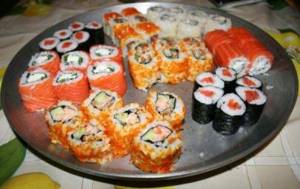
How nice it would be to start making sushi yourself! But the rolls promise to turn out to be especially “Japanese”, as if imbued with the spirit of this eastern country. An attempt to make rolls at home filled with seafood cannot fail. Moreover, for this you will need to buy only certain ingredients and makis. Further actions should be performed according to the following step-by-step scheme:
- boil the rice;
- when cooled, lay it out on the elevator mat;
- Place the cooked rice on top of the bamboo mat;
- put a little wasabi on the rice and the filling on the edge;
- using makisa, we roll all the “good” into a roll;
- carefully cut into equal parts (you should get 10-12 pieces).
In Japan, becoming a professional sushi chef is not so easy: it requires a lot of practice and study for at least ten years. Therefore, if it doesn’t work out the first time, don’t despair! In order to comprehend all the nuances, you always have plenty of time! Good luck in the kitchen and culinary success!
Nothing on topic
Filling for sushi and rolls at home
Go to a Japanese restaurant or order sushi delivery to your home? In a moment of nostalgia for Japanese dishes, perhaps these two ideas are the very first. However, we suggest you go to the kitchen and put the rice on the fire to cook. After all, preparing sushi at home is not difficult if you consider this process step by step.
One of the most entertaining and interesting is choosing the filling for rolls.
Don't be upset if on the eve of a sushi party there is neither tobiko caviar nor smoked eel in your house. It’s worth opening the refrigerator and turning on your imagination.
Listed below are products that have long become a common component of rolls. And what’s important is that you can buy them without visiting large supermarkets and specialty Japanese food stores.
Fish and seafood
Where there is sushi, there is rice and fish. Traditionally, Japanese cuisine uses sea fish, which is due to both geographical factors and practical considerations: due to its habitat in salty waters, it does not contain parasites.
Salmon, trout, salmon are used for filling rolls both fresh and lightly salted or smoked. As a rule, processed foods are sold in stores in portioned pieces or cut into thin slices.
Sea bass and herring reveal their taste well in sushi.
The most commonly used seafood are shrimp and mussels. And the expensive Kamchatka crab meat was replaced, not without success, by crab sticks.
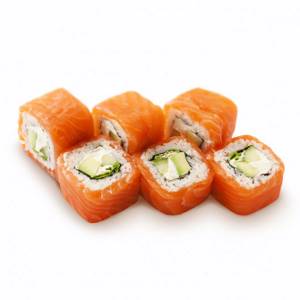
Salmon, soft curd cheese and cucumber are the basis of your favorite Philadelphia rolls. Cucumber can be either fresh or pickled. If desired, you can add avocado to the filling.
Meat
Meat is not typical for Japanese sushi, but on Russian soil, recipes including smoked or boiled chicken are always popular. Don't forget about strips of bacon - they can be used to stuff or wrap rolls like nori seaweed.
Smoked chicken, cucumber, avocado and mayonnaise - a hearty snack in a couple of minutes.
Soft cream cheeses
Who said that you should definitely buy Philadelphia cheese with Philadelphia rolls? Often, professional sushi chefs deviate from the standard recipe, replacing Philadelphia with inexpensive cremette cheese, or creatively rethinking the recipe and including curd cheeses based on cream and milk. The latter add a more delicate taste to the dish and, in addition, make the cook’s work much easier, since they do not spread when preparing rolls.
Bell pepper, cucumber, tomatoes, lettuce, mayonnaise or cheese are a traditional combination for vegetable rolls.
Vegetables and greens
A Russian favorite, cucumber is an essential ingredient in the famous California uramaki, invented in Los Angeles in 1973. As a rule, long elongated cucumbers are selected for sushi, which are then carefully crumbled into strips.
Tomatoes, bell peppers, green salad and regular carrots - everything that is in the lower compartment of your refrigerator can also be safely included in vegetable and vegetarian rolls. In this case, it is recommended to put all products out of the refrigerator in advance, and when processing them, be sure to remove the seed boxes. The Japanese usually do not eat vegetable seeds; in addition, if cucumber cores are used, the sushi becomes too wet and does not hold its shape.
Fruits
Apples, bananas, oranges, kiwis and any seasonal berries will make a wonderful filling for sweet sushi. In combination with cottage cheese and soft cheeses, they are quite capable of replacing cakes and pastries at any children's party. And of course, a good half of roll recipes are unthinkable without avocado - a universal fruit, without which it is difficult to imagine Japanese cuisine. When purchasing, pay attention to the degree of readiness of the fruit: a ripe avocado is slightly wrinkled and can be squeezed.
Salmon, avocado and shrimp - a quick solution with delicious results. The salmon in this recipe can be replaced with soft curd cheese such as Philadelphia.
Mayonnaise
In Japan, with its rich sauce culture, there is no need for mayonnaise as such. The so-called “Japanese mayonnaise” - absolutely neutral in taste - only vaguely resembles the product we are familiar with. Sauces based on it are traditionally added to California rolls. It is usually made from a mixture of yolks, rice vinegar, oil and miso paste, and can be easily prepared at home if you have all the ingredients. Otherwise, you can use regular store-bought mayonnaise with a fat content of at least 60%.
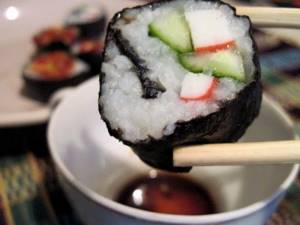
The simplest filling for rolls includes crab sticks, mayonnaise, cucumber or avocado.
As you can see, there are no obstacles to quickly preparing sushi at home. Most of these products can be found in any kitchen, and a piece of salmon is enough to prepare excellent nigiri or hosomaki in a few minutes. All you have to do is cut the fillet into thin slices and combine with rice and nori.
Try combining products from different categories into sushi fillings, add roasted sesame seeds, lettuce or green onions... And make sure that experimenting with roll fillings is as exciting as it is delicious!
How to make rolls at home in Japanese?
- Cut the tuna into thin and long strips 5mm thick.
- Lay the bamboo mat on your work surface with the slats from left to right so that you can roll it away from you.
- Place a half sheet of nori on top, near the front edge of the mat.
- Spread about 3/4 cup of rice over the surface of the sheet, leaving an uncovered strip of seaweed on the opposite edge.
- Place the tuna horizontally on the rice.
- Roll the bamboo mat by pressing forward to form a log.
- Roll up from the front end, pointing the mat away from you.
- Tighten and press lightly with your hands.
- Then remove the mat and remove the roll.
- Repeat with the rest of the rice, tuna and seaweed.
Serve immediately with Japanese side dish.
